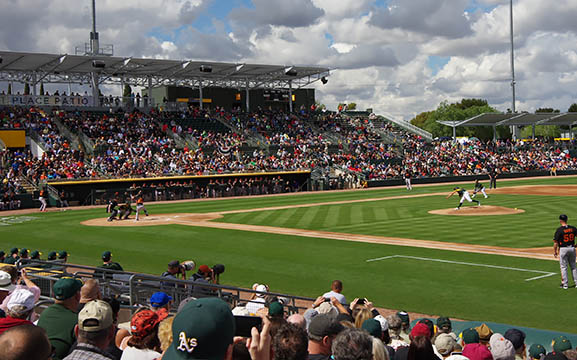 |
City of Mesa partners with A’s to transform HoHoKam Stadium
Text and photos by Joe Mock, BaseballParks.com
All rights reserved
MESA, ARIZONA You’ve no doubt heard someone say that one day he woke up and looked in the mirror, and couldn’t believe how old he’d gotten. Just maybe, it’s happened to you.
Well, it happens with ballparks, where you attend games year after year and you don’t notice that it’s looking tired. A stadium’s aging process happens so slowly, so gradually, that if you’re a constant visitor, you don’t even notice.
Such was the case with HoHoKam Stadium, once the jewel of Arizona’s Cactus League. When the Cubs moved into the sparkling new facility (a new stadium was built on roughly the same spot as HoHoKam Park, which was also a spring-training ballpark) in 1997, attendance records fell left and right. For the team, much of the morning workouts occurred a mile to the south, at Fitch Park, while the afternoon exhibitions were at the main ballpark.
All was well until the Cubs began to notice that the facilities weren’t keeping pace with the new palaces being built in Goodyear, Glendale and Salt River. And after years of the desert sun beating down on the seats and the structure, it was looking tired — whether frequent visitors like me noticed it or not. In addition, HoHoKam’s location (a cemetery on one side and an old residential part of Mesa on the other) precluded any possibility of commercial development adjacent to the ballpark. The Cubs weren’t happy.
The City of Mesa knew that it would be an economic catastrophe if the Cubs left town, so a new complex was built for the team on the western edge of Mesa. In 2013, the Cubs said goodbye to their springtime home, and we covered the final game.
Meanwhile, the A’s weren’t thrilled with their spring training facilities not far away in eastern Phoenix. Their Minor Leaguers trained in a set of practice fields in Papago Park, while the Big Leaguers trained and played about two miles away at Phoenix Municipal Stadium — and other than refurbished dugouts and press box in 2003, it was largely unchanged since the 1960s.
According to Marc Heirshberg, Mesa’s Director of Parks & Recreation, when the A’s learned that the Cubs were moving out, they contacted the City of Mesa to inquire about HoHoKam’s availability — not the other way around, as many have assumed. Apparently, the A’s requests to the City of Phoenix for significant upgrades to Papago Park and Phoenix Muni weren’t being heeded.
Heirshberg noted that the deal wasn’t a slam dunk at all, as the A’s truly performed due diligence in assessing the financials of the arrangement. In my mind, Mesa had to view the A’s as a gift from heaven, because the City didn’t have to spend $85 million constructing a brand-new complex to attract a second team to town, plus it solved the problem of what to do about an about-to-be-abandoned HoHoKam Stadium.
 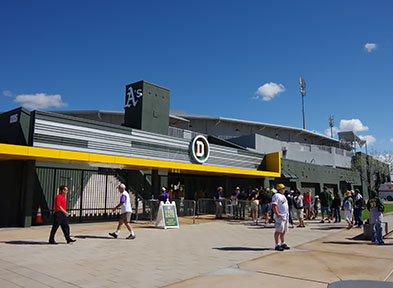 |
| Before and after: on the left is the way HoHoKam looked when the Cubs played their last exhibition there in 2013. On the right is the same scene the day the A’s played their first game as the home team there in 2015. |
The A’s moved into the facilities in January 2015 — while the construction work was still going on — and the triumphant rebranding of the complex was complete when the first exhibition game was played on March 3 against their Bay Area rivals, the Giants. The photo at the top of this article is the first pitch at the transformed HoHoKam, as Brad Mills of the A’s fires a strike by Nori Aoki.
The financials break down like this: the City agreed to cover the first $15 million of the cost, using cash reserves; the team and the City then split the next $5 million of costs 50-50; everything above $20 million is covered fully by the A’s — meaning they could make tweaks and enhancements along the way without going back to the City for more money. The City, meanwhile, hopes to recover $8.2 million of its costs from the Arizona state authority that provides financial assistance to municipalities who are working to attract or retain spring-training tenants.
Since the total project ended up costing in the neighborhood of $26 million, that means the A’s paid about $8.5 million and the City about $17.5 million — or $9.3 million if the State reimburses the City the $8.2 million. From the A’s perspective, they would never have seen their share in a brand-new complex be as little as $8.5 million, and the City’s net of $9.3 million is a pittance compared to the amount of money they’d have to cough up in building a new complex (it was $84 million for the new Cubs complex, by way of example). All of the operational costs of conducting spring training, by the way, are being paid by the team.
In exchange for the public funds spent on the project, the A’s agreed to a 20-year lease, with two five-year options on the back end.
What did the $26 million buy? A lot, actually — especially when you consider that it also paid for the massive expansion and improvements at the Fitch Park complex down the street. When I asked Heirshberg what changes were being made, it took him over six minutes to list and describe them all!
  |
| The ticket windows and entry gates have been expanded. On the right is the new entry gate near the left field foul pole. It means fans parked in the huge lots beyond the outfield no longer have to walk as far to enter the park. |
If you look at the modifications of the ballpark itself, the list is very long. First, the exterior went through a “rebranding” that removed the entire color scheme from when the Cubs were here. Openings were made in the exterior walls that allow natural light to help illuminate the concourse inside — a monumental change from the dark, dreary walkways under the stands before. Larger windows were built into the walls of the merchandise store and the entry gates were significantly widened. In fact, fans can now enter through the “A” gate near the left field foul pole, which is extremely helpful if you’re one of the thousands of fans who have to park in the lot beyond left field.
  |
| The “rebranding” of HoHoKam included images of past Oakland heroes. On the right, Ovations (the food service and merchandise vendor at the ballpark) displays some flexibility by using open space for beer kiosks and souvenir sales. |
Inside, images and logos that convey “OAKLAND A’S” are everywhere. What were cramped walkways are now more open — even to the extent of having a changeable area beneath the stands that can accommodate beer carts and merchandise sales (to help keep lines shorter at the main store down the hall). What were little-used bleachers down the foul lines have been replaced by covered picnic areas — and the one on the third-base side is fully tricked out with Astroturf “carpeting” and a beautiful canopy, providing much-desired shade. A tremendously enhanced team store was also added.
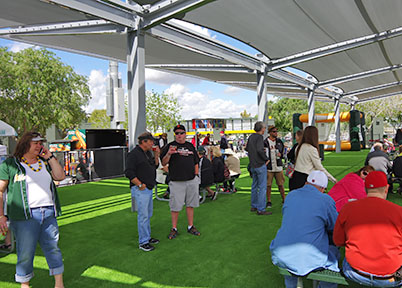  |
| On the left is the beautiful picnic pavilion, complete with Astroturf, canopies for shade and beer carts. Also above is the high-def video screen, new this year. |
And almost every fan is impacted by this change: every one of the old, uncomfortable, sun-faded seats was replaced. This alone makes the ballpark look like a brand-new facility.
Also, every fan can enjoy the new scoreboard. Frankly, for the last seven or eight years the Cubs were at HoHoKam, the decidedly low-tech scoreboard was simply inadequate compared to the barest of modern-day standards. Well, now A’s fans can enjoy the largest high-def video screen in the Cactus League.
Just as new seats and a huge high-def scoreboard are important to the fans, so too is the food. And the concessions here are northing short of fantastic. Ovations Food Service had already made a name for itself in Oakland (turning the food quality at O.co Coliseum from below average to top-shelf) and in the new Cactus League venues in Salt River Fields and the Cubs’ new complex that opened in 2014. Using their corporate philosophy of “always fresh,” the concessions are prepared on the spot, and the aesthetics of the stands themselves are a huge upgrade.
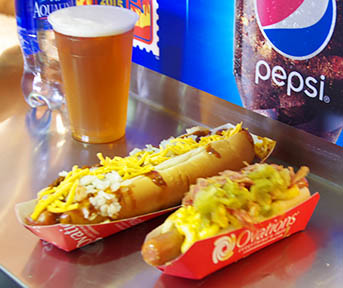  |
| Ovations’ approach to stadium food is to make it fresh, like the Oak Dog in the foreground of the lefthand photo above. Ike’s is an innovative and popular sandwich chain in both California and Arizona. |
As is often the case when Ovations runs the concession show at a ballpark, familiar names adorn the stands. For instance, Ike’s Place is a popular sandwich-shop chain in the Bay Area and more recently in Mesa and nearby Tempe. The stand at HoHoKam features the Mark McGwire (turkey, bacon and jack cheese) and my favorite, the Menage a Trois (halal chicken, BBQ, honey mustard, real honey and jack cheese}. The food service manager for Ovations, Jay Satenspiel, explained that the wonderful bread they use is prepared in San Francisco, frozen and flown to Arizona — and it is delicious. All sandwiches here are $9, and are worth it.
The Oak Dog is another new take on an old favorite. It’s a hot dog topped with macaroni and cheese, hatch green chillies and crumbled bacon. Messy, yes, but quite a beautiful combination of flavors. Other clever new dishes are fry bread topped with beef or chicken, and the Slider Trio (one slider with buffalo chicken, one with pulled pork and the last is a Black Angus cheeseburger topped with bacon). Ovations also does the food at El Paso’s new Southwest University Park — arguably the best food in the Minors –and this type of slider assortment is a big hit there.
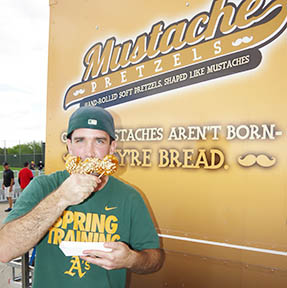 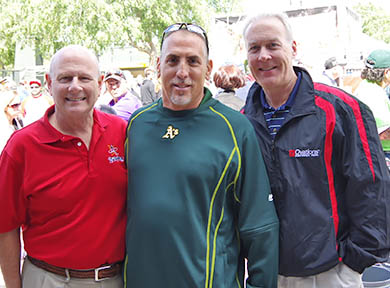 |
| Greg Golden shows how his pretzels are shaped like a mustache. On the right, my Ovations tour guides for HoHoKam’s concessions were (from left) Ken Young, President, Jay Satenspiel, Regional VP and Charlie Neary, Executive VP. |
Another tasty food offering can be found at the food truck near the right field foul pole. Mustache Pretzels are, well, pretzels baked in the shape of a mustache. Owner Greg Golden explained to me that his food truck made its debut out in the parking lot at A’s exhibition games at Phoenix Muni in 2014. They were a hit, and are now inside the park’s perimeter at HoHoKam. The menu features The Original at $5, and three specialty items at $6: Garlic Parm; Cinnamon Sugar and my favorite, the “Nut-stache,” which is covered with caramel and chopped nuts. “At ball games, about 60% of the customers get the Original with a side of queso,” Golden explained.
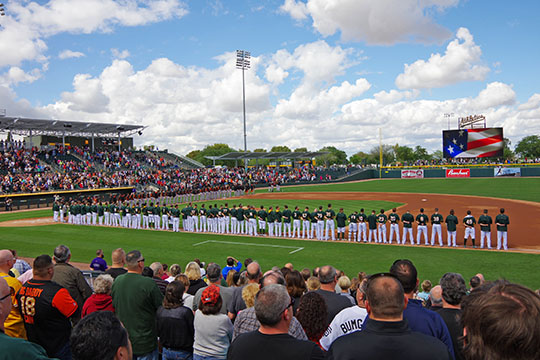 |
After the City of Mesa announced that the A’s were going to move their spring operations to HoHoKam and Fitch after some much needed renovations would be completed, I asked an architect if they were interested in being the designers on this makeover. He said that they weren’t because it wasn’t going to be a very extensive project. Well, after visiting HoHoKam, I have to say that the renovations were indeed quite extensive. Not only that, they were badly needed and were expertly carried out. Job very well done!
If you’ve attended a game at HoHoKam, feel free to post your own observations below.